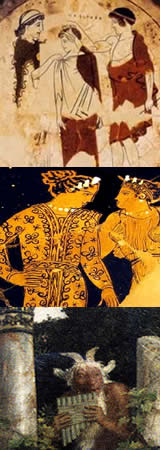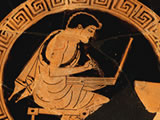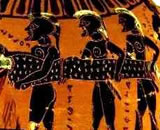
















Ancient olympia history

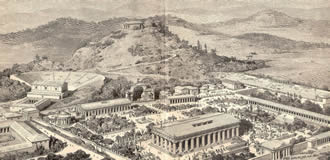
Inside
Education-Religion
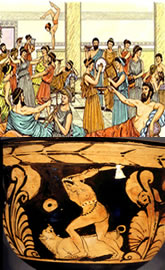
Childhood
Children lived with their mothers in the women's quarter until they were 7 years old. They slept in wicker baskets or wooden cradles. The children played with balls, miniature chariots, rattles, yo-yos, rocking horses, and dolls and animals made from clay. Many had pets. They especially liked dogs. Other pets included ducks, quail, birds, goats, tortoises, mice, weasels, and grasshoppers. At age 7 the boys went to school Schools The schools varied from one city-state to the next. The Spartans were the most envied by the Greeks. They were taught to be tough from an early age.
Spartan Schools
When babies were born in Sparta, Spartan soldiers would come by the house to examine them. If the baby did not look healthy, it was taken away and left to die or trained as a slave. If the baby was healthy, it was assigned membership in a brotherhood or sisterhood.
The boys in Sparta were sent to military camps of their brotherhood when they turned 7. They learned how to read and write until they were about 14. The Spartan government wanted to make the boys tough. To do this they were given little clothing and no shoes. They slept on hard beds made of reeds and were not given any covers. They were not given enough food. They were trained in survival skills and how to be a good soldier. Reading and writing were taught as secondary skills.
Between ages 18 to 20 each boy had to pass a fitness test. If he did not pass the test, he became a perioidos. This was a person of middle class who had no political rights and was not even considered a citizen. If the boy passed he served in the military and continued to train as a soldier. Military service lasted until the boy reached age 60.
The girls were trained in the school of their sisterhood. They were taught physical education. Classes include wrestling, gymnastics, and combat training. The Spartans wanted girls to be strong so that they would have healthy children. At age 18 the Spartan girl had to pass a fitness test. She was then assigned a husband and allowed to return home. If she failed the test, she became a perioikos.
Athenian Schools
Boys were taught at home by their mothers until they were 6 or 7 years old. In Athens the education was left up to the father. Students were taught by private schoolmasters. The boys from wealthy families were taken to school by a trusted slave. The students learned to write on wax-covered tablets with a stylus. Books were very expensive, so they were rare. The students in Athens learned to add, subtract, multiply, and divide. They also learned about fractions. Students learned the words of Homer and how to play the lyre. Boys were trained in sports. Wealthy children learned to ride horseback. Other sports included wrestling, using a bow and a sling, and swimming. At age 14 boys attended a higher school for four more years. At age 18 boys went to military school. They graduated at age 20.
Roles of the Men and Women
Men In Greece the men ran the government. They spent a lot of their time out of the house while involved in politics. Men also spent time in the fields overseeing the crops. They sailed, hunted, and traded. All of these activities took the men away from home. Men enjoyed wrestling, horseback riding, and the Olympic Games. Men had parties in which the women were not allowed to attend.
Women had little freedom. Wealthy women hardly ever left the house. They sent slaves to the market. They were allowed to attend weddings, funerals, and some religious festivals. Their job was to run the house and bear children. Greek women supervised slaves who did all the cooking, cleaning, and tending of the crops. Male slaves guarded the women when the men were away. Except in Sparta girls did not go to school. They learned only the basics of reading and math at home. Girls were taught how to run a house. Women lived in a special section of the house called the gynaeceum.
Marriage
Athenian Marriage
The day before the wedding the girl took a bath from a sacred spring. The water was poured from a vase called a loutrophorus. The girl then worshipped the goddess Artemis. She offered the goddess symbols of her childhood such as toys and a lock of her hair.
Marriages usually took place in January. Wedding ceremonies started after dark. The bride traveled from her home to the home of her groom in a chariot, or a wagon if she was poor. Friends of the bride and groom lit the way with torches. They played music to scare away the evil spirits. The bride would eat a piece of fruit at the ceremony to show that food and other basic needs would come from the husband. Marriages were arranged by the father of the bride. The bride did not even meet her future husband until the day of the wedding. Girls married at about age 15 and her groom would be about twice her age. Grooms were given a dowry. If the husband died, the dowry and girl would return to her father.
Spartan Marriage
Spartan women were not given a special celebration on their wedding day. The ceremony was brief and private. Afterwards the husband and wife would meet in secret until the husband reached the age of thirty. At that time he was allowed to live in the same house as his wife.
Divorce
Divorce was quite common and allowed. The women would frequently remarry.
Clothing
Greeks wore simple free-flowing clothing. Most clothes were made of wool or linen. The wool was woven into a lightweight material. The wool was often dyed using natural dyes from plants. In the fifth century B. C. cotton was imported from India. Only the rich could afford to buy it. Most families made their own clothes. They were made by the women in the family or by female slaves. They were decorated to represent the city-state in which they lived.
Tunics called chitons were formed by draping a piece of rectangle-shaped cloth around the body with belts, hooks, buttons, or brooches. Up until the sixth century the women wore a rectangle of woven wool. It was about six feet wide and about 18 inches longer that the height of the person wearing the garment. The fabric was wrapped around the wearer with the extra material folded over the top. It was pinned on both shoulders with the extra material falling free looking like a cape. The pins used for fastening the garment were open with a decorated head. During this time period the men wore similar chitons that came to the ankles. During the fifth century the men began wearing shorter chitons with one shoulder pinned.
Until the fifth century garments were white. Beginning with the sixth century the clothes were decorated with a wide range of colors. Later the tunic was replaced by thin linen or occasionally silk. At this time the fabric was much wider and could measure up to 10 feet wide. The length was measured from the wearer's shoulder to the ankle with no extra. The tunic was fastened on both sides of the neck with two long pins or metal brooches called fibulae. The fabric was pulled in at the waist with a belt. At this time the chiton sleeves were popular with the ladies. These were made by fastening the ends of the two pieces fabric many times from the shoulder to the wrist. The fabric pulled away from each clasp making oval shaped openings all along the arm. The men's tunics were wore at knee-length. The women wore their tunics to the ankles.
Both men and women wore cloaks called himation. These were also made from a rectangular piece of fabric. The men's were usually knee-length while the women's were long.
Greeks wore shoes when they went outside. Everyone had strapped sandals. Boots were made of leather. The women wore ankle length boots while the men wore heavy boots with laces.
Hair
The women wore their hair long. They arranged it in braids on top of their heads. The styles were held in place with waxes and lotions. Women tied back their hair with cloth headbands called cecryphalaes. These wrapped around the head.
Men kept their hair short. They wore beards unless they were soldiers.
Food
The Greeks eate three meals each day. Breakfast was eaten at sunrise. They ate a small midday meal and a late afternoon snack. The main meal was eaten at the end of the day. The soil was poor along the coast. With irrigation and crop rotation the Greeks were able to raise some crops. The soil was more rich in the plains. In the plain regions the Greeks were able to raise wheat and barley. Greeks made a large variety of breads including milk bread, rye bread, wheaten bread, farmhouse bread, brown bread, braided bread, and square bread. Because wheat could only be raised on the plains, there was not enough to feed all the people in Greece.
Greeks grew olives, grapes, and figs. Other fruits that were eaten were apples, prunes, apricots, cherries, and dates. These fruits were often baked into cakes and pies which were sweeten with honey. In their gardens they raised peas, navy beans, and lentils. Green vegetables were rare and very expensive. The Greeks cultivated mushrooms beginning in the fifth century B. C. They kept goats for milk and cheese. Some kept chickens for their eggs. Many foods were cooked in olive oil.
Greeks usually drank water. Some drank goats' milk. Another drink was made with fermented honey. Homemade wine was very popular with the rich. It was thick and heavy and had to be diluted with water.
Meat was rarely eaten. It was mostly used for religious sacrifices. Greece had a lot of wild game to hunt. Hunters found pheasant, partridge, quail, and wild guinea hens. They also hunted wild boars, bear, deer, foxes, weasels, hares, moles, cats, porcupines, and hedgehogs. Greeks ate a lot of fish and seafood. Fishermen caught gilt-heads, mullets, turbot, and tuna.
Ancient Greeks didn't use napkins. Instead they wiped their hands on pieces of bread which were given to the dogs. They ate stew and porridge with spoons. They cut their meat with knives. No forks were used. Meals were served on plates made from wood, clay, or metal.
Additional Entertainment
Agora (marketplace) The marketplace was for men. Young boys and women were not allowed to come until the afternoon. This large space of about 100 by 200 meters held barbershops, bathhouses, perfume vendors, drinking establishments, and brothels.
Gymnasia (gym) The gymnasia was a large exercise yard surrounded by changing rooms, practice rooms, and baths. The Greeks wanted healthy bodies. Due to this they spent a good portion of each day exercising in the gym. Wrestling, boxing, and javelin and discus throwing were enjoyed sports. Athletes wore no clothes while exercising. They oiled or dusted their bodies before and after exercising.
Theater - large open theaters were built in many cities.
Classes of People
Freemen - divided into classes
Lowest class were the thetes (urban craftsmen)
Middle ranks - small farmers
Top - aristocrats who owned large estates
Many occupations fell between these classes.
Metics - free non-citizens - Metics were usually Greeks from other city-states. They worked in low paying jobs.
Slaves -
Highest Level - some worked as tutors and police officials
Middle Level - domestic slaves - often considered one of the family
Lowest slave worked in the mines
Women - had few rights - often treated like a domestic slave.
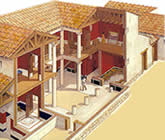
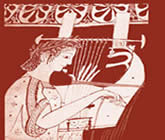
Entertainment
Dance was very important to the Greeks. Some dances were for men, and others were for women. Over 200 dances were performed by the Greeks. Dancers were accompanied by lyres, flutes, and percussion instruments.
The Greeks created many stories. Aesop's Fables were written by an Ancient Greek.
The Greeks had many religious festivals.
- Festivals
Cronia - harvest festival
Panathenaea - festival in honor Athena
Great mysteries of Eleusis - 11 days
Apatouries - festival in honor of Athena an Zeus
Pyanepsies - Apollo
Thesmophories - Demeter
Oschophories - Dionysus and Athena
Kalkeia - Athena and Hephaetus
Italoa - Demeter and Dionysus
Rural Dionysian festival
Lenaea - festival in honor of Dionysus
Anthesteries - festival in honor of Dionysus and the dead
Minor mysteries of Eleusis
Diasies - festival in honor of Zeus
Chloia 0 Demete
Procharisteria - Athena
Great Dionysia - 6 days
Targelies - Apollo or Demeter
Thalysies - Demeter and Cora
Skira - Demeter and Cora
Dipolies-Bouphonies - Zeus
Arrtophoria - Athena and Aphrodite
Pan
favourite trick of Panas was to torment ancient Greek travellers. Pan would lie
in wait in the bushes for his victims. When they passed by his hiding
place he would gently rustle the bushes; causing a sense of uneasiness in the person walking by. They would soon pick up their pace, and then Pan would scurry through the forest to intercept them at the next dark turn of the path. He would rustle some more vegetation... play a few weird notes on his pipes and duck just out of vision... and the traveller would make even greater haste as Pan'samusement grew
The today word panic come from the name of Pan.
